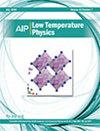Peculiarities of obtaining nanocomposites with organic additives and consolidated nanomaterials with given properties
IF 0.8
4区 物理与天体物理
Q4 PHYSICS, APPLIED
引用次数: 0
Abstract
The work presents the results of the creation of consolidated nanomaterials and composite ceramics using modern methods of consolidation of ceramic materials for the synthesis of powder precursors and specified phases that self-reinforce ceramic matrices. The method of mechanosynthesis and electroconsolidation is used. The results of the use of these trends for the creation of promising composite materials are given. The use of mechanochemical synthesis of β-SiC nanoparticles in nanoreactors, involving the organic-inorganic complex (–CH3)–(SiO2)n and the modification of refractory filler powders and carbon bonds using silicon alkoxide and related gels, has been demonstrated to enable the production of composite materials. These materials are composed of SiC, WC, and ZrO2, exhibiting a minimum bending strength of 650 MPa and crack resistance ranging from 6.5–7.9 MPa m0.5. Furthermore, this method can also produce periclase-carbon materials known for their exceptional resistance to oxidation and slag.有机添加剂和固结纳米材料制备纳米复合材料的特点
这项工作展示了利用现代陶瓷材料固结方法合成粉末前体和自增强陶瓷基体的特定相的固结纳米材料和复合陶瓷的结果。采用机械合成电固结法。最后给出了利用这些趋势制造有前途的复合材料的结果。利用机械化学方法在纳米反应器中合成β-SiC纳米颗粒,包括有机-无机配合物(- ch3) - (SiO2)n,以及使用硅烷氧化物和相关凝胶改性耐火填料粉末和碳键,已被证明能够生产复合材料。这些材料由SiC、WC和ZrO2组成,其最小抗弯强度为650 MPa,抗裂强度为6.5-7.9 MPa m0.5。此外,这种方法还可以生产出以其优异的抗氧化性和抗渣性而闻名的方晶石-碳材料。
本文章由计算机程序翻译,如有差异,请以英文原文为准。
求助全文
约1分钟内获得全文
求助全文
来源期刊

Low Temperature Physics
物理-物理:应用
CiteScore
1.20
自引率
25.00%
发文量
138
审稿时长
3 months
期刊介绍:
Guided by an international editorial board, Low Temperature Physics (LTP) communicates the results of important experimental and theoretical studies conducted at low temperatures. LTP offers key work in such areas as superconductivity, magnetism, lattice dynamics, quantum liquids and crystals, cryocrystals, low-dimensional and disordered systems, electronic properties of normal metals and alloys, and critical phenomena. The journal publishes original articles on new experimental and theoretical results as well as review articles, brief communications, memoirs, and biographies.
Low Temperature Physics, a translation of the copyrighted Journal FIZIKA NIZKIKH TEMPERATUR, is a monthly journal containing English reports of current research in the field of the low temperature physics. The translation began with the 1975 issues. One volume is published annually beginning with the January issues.
 求助内容:
求助内容: 应助结果提醒方式:
应助结果提醒方式:


